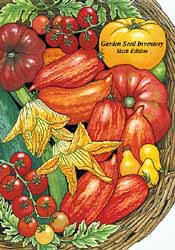- Ancient olives not that old after all. But still attractive.
- Giving up tobacco – in favor of purple sweet potatoes?
- Kew is now as much about cooking as growing. Visit the 18th century kitchens.
- Linking small farmers to markets, video from a conference.
- The International Treaty’s SMTA made easy. Well, kinda. It would have been even easier if they had linked to the site. Good thing there’s us, eh?
D Landreth not so important to seed diversity
 Thanks to the very good offices of our friends at Seed Savers Exchange, I now have a copy of the most recent (6th) edition of the Garden Seed Inventory. I wanted this in order to see whether the loss of The D. Landreth Seed Company, America’s oldest, as it happens, while tragic for the business and its customers, would also be a great loss for agricultural biodiversity. Long answer short: not so much.
Thanks to the very good offices of our friends at Seed Savers Exchange, I now have a copy of the most recent (6th) edition of the Garden Seed Inventory. I wanted this in order to see whether the loss of The D. Landreth Seed Company, America’s oldest, as it happens, while tragic for the business and its customers, would also be a great loss for agricultural biodiversity. Long answer short: not so much.
The Garden Seed Inventory is a catalogue of catalogues, listing all the varieties available from all the catalogues SSE can get its hands on. That makes it a very useful snapshot of what is out there (in the US), how widely available it is, and the ebbs and flows in comercially-available diversity of crops and varieties. The Introduction to the book contains lots of analysis of this type, and I thought I remembered that it listed all the varieties that are available only from a single supplier and each supplier’s “unique” varieties. It doesn’t.
It does, however, list the 27 companies (10% of the total number covered by the inventory) that list the most unique varieties. D. Landreth is not among them. It also lists the companies that had introduced the most “new unique varieties”. Perhaps unexpectedly, there’s quite an overlap with the “most uniques”. and D Landreth isn’t in that list either. All of which suggests to me that while the passing of D Landreth would indeed be sad for its owners and customers, it would not be an immediate disaster for commercially-available agricultural biodiversity in the United States.
Does D Landreth have any varieties not available elsewhere? That one is difficult to answer using the Inventory. More than 450 pages of closely spaced entries is a lot to look through, searching for those with a single source coded La1. It ought to be a doddle from the database that stores the original records, but I’m sure SSE has much else on its mind at the moment. Mind you, if 45 owners of the Inventory were to scan 10 pages each …
Nibbles: Weeds, Cardamoms, Bananas
- High-level summit on weed management does little to inspire confidence (in me).
- Careful with that cardamom! Forests may suffer.
- A crop wild relative – with photo! – among “ten extremely rare seeds”. I think they mean “extremely rare species”.
Nibbles: Mapping Life, PES, Quinoa, Forest restoration
- Mapping Life is live. Will livestock and crops eventually be there?
- How Valuing Nature Can Transform Agriculture. Errr … dunno. Is this really brainfodder?
- A humble agronomist considers the de-commoditisation of quinoa in Bolivia.
- Bioversity says that forest restoration should make better use of genetic diversity.
Feral or relict: you decide
What do you call an escaped agricultural plant? I ask because two recent items have made me wonder. Exhibit A, a Zester Daily article entitled Wild Apple Adventure. Naturally I conjured up scenes of derring do in the mountains around Almaty. How disappointing, then, to discover that Zester’s version of “wild” is actually “feral,” apple trees that have either survived the orchard around them or else are seedlings growing in the wild.
Exhibit B, a recent announcement on a mailing list of a meeting on Nordic Relict Plants. ((Which I’m sure they won’t mind me repeating. It takes place on 26-27 July, in Iceland, and while it does not seem to have an online presence, as yet, you can get further details from Erik Persson. Tell him we sent you.)) I’d always thought of relicts as leftovers from massive ecological changes, like relict rain forests, or relict pockets of pre-ice age flora. But no …
This meeting is for everyone with an interest in relict plants, particularly but not exclusively, in Nordic and Arctic areas. By a relict plant we mean a plant species or variety that was, but is no longer, cultivated in a particular place, and has survived in that place after cultivation stopped. These plants are important parts of our cultural history and can sometimes contain genetic material that is different from more modern varieties of the plant.
So, what should one call these plants? Wild, to me, sounds wrong. Feral, most dictionaries I consulted agree, suggests both “not domesticated or cultivated” and “having escaped from domestication”. To which at least one helpfully adds “having escaped from domestication and become wild,” which is surely not true of erstwhile crops.
I rather like “relict”. What do you think?”